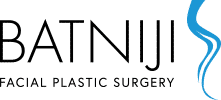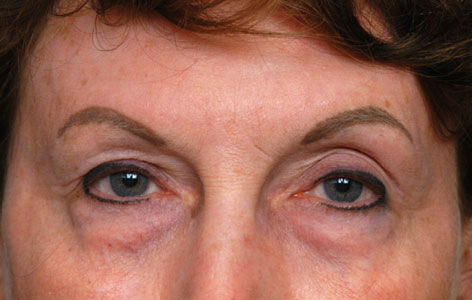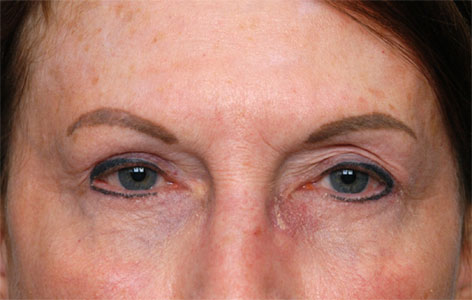Lower Blepharoplasty in Newport Beach and Beverly Hills
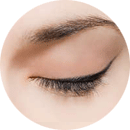 Lower eyelid surgery is a procedure which corrects fullness and excess skin of the lower lids, as well as hollowness between the cheek and lower lid, also known as a nasojugal groove and/or tear trough deformity. Technically known as lower blepharoplasty, the surgery can improve a tired or aged lower eyelid appearance and restore a more youthful and refreshed look.
Lower eyelid surgery is a procedure which corrects fullness and excess skin of the lower lids, as well as hollowness between the cheek and lower lid, also known as a nasojugal groove and/or tear trough deformity. Technically known as lower blepharoplasty, the surgery can improve a tired or aged lower eyelid appearance and restore a more youthful and refreshed look.
Who is the ideal candidate for a lower blepharoplasty?
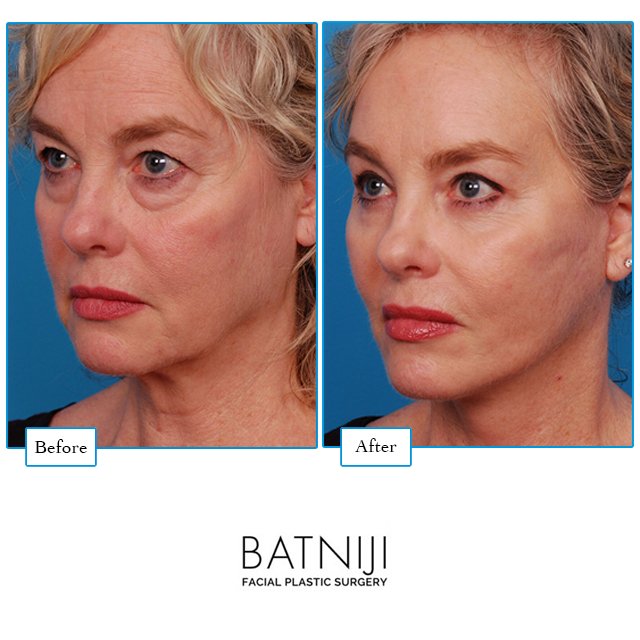
Lower eyelid surgery is appropriate for healthy men and women who have reasonable expectations for improving fullness, excess skin and/or hollowness of the lower eyelids. Patients should be free of any known ophthalmic conditions. Fine lines, wrinkles, and sun damage occurring along the lower eyelids may be better treated with other procedures such as skin resurfacing or Botox injections. Dr. Batniji will meet with you for a consultation to examine your eyelids and discuss your concerns in order to determine the best procedure to address your needs.
Why choose Newport Beach blepharoplasty specialist Dr. Batniji?
As a specialist in facial plastic surgery, Dr. Batniji has dedicated his practice to beautifying the face. He is board certified by the American Board of Facial Plastic & Reconstructive Surgery and by the American Board of Otolaryngology. He is able to provide his patients with beautiful, long-lasting lower eyelid surgery results due to his unique understanding of facial aesthetics and his vast knowledge and expertise in facial plastic surgery techniques.
Dr. Batniji is affiliated with several accredited surgery centers and hospitals throughout Southern California, and your lower eyelid surgery may take place at any one of these. He most commonly performs surgery at the Newport Beach Surgery Center and Hoag Hospital, both of which are located in Newport Beach, California. Dr. Batniji is also a member of the Department of Otolaryngology-Head and Neck Surgery and the Department of Plastic Surgery at Hoag Hospital. He is an educator, lecturer, and acknowledged leader in his field.
What Conditions Can A Lower Blepharoplasty Improve?
A lower blepharoplasty is a type of eyelid surgery intended to improve the appearance of lower eyelid bags, chronic lower eyelid puffiness, and lower eyelid drooping. The procedure can give you a more refreshed and alert appearance but with a natural look. Furthermore, many patients choose to undergo a lower blepharoplasty to reduce or eliminate signs of aging.
Humans naturally make eye contact with each other, and the eyes are one of the first areas we notice about other’s appearance. A lower blepharoplasty can create a dramatic improvement in your appearance and self-confidence.
What Is The Lower Blepharoplasty Cost?
Medical insurance usually will not cover the cost of a lower blepharoplasty since it is a cosmetic procedure. In rare instances, a lower blepharoplasty may be deemed medically necessary. An example of such a case would be in the event that the lower eyelids are obstructing vision. In these cases, insurance may cover some or all of the costs of lower eyelid surgery. Otherwise, a lower blepharoplasty is among the more affordable cosmetic surgeries.
Where can I view examples of Dr. Batniji’s blepharoplasty techniques?
Click here to view our Newport Beach lower eyelid surgery before and after photo gallery.
How Long Do Lower Blepharoplasty Results Last?
Due to the anatomy of the lower eyelid and Dr. Batniji’s advanced surgical techniques, lower blepharoplasty results can be quite long-lasting. Most patients can expect their results to last for 10 years or more, depending on factors like genetics, lifestyle, and sun exposure. In fact, some patients note an improvement in the appearance of their lower eye area for the remainder of their lives.
How long does lower blepharoplasty with Dr. Batniji take?
Lower eyelid surgery takes approximately one to two hours to perform. The procedure almost never requires an overnight hospital stay and is done on an outpatient basis.
Is blepharoplasty done with general anesthesia?
Most commonly, lower eyelid surgery utilizes monitored anesthesia or general anesthesia.
What happens during a lower blepharoplasty (lower eyelid) surgery?
The incision is small and well-concealed, being located either within the lower eyelid or a few millimeters below the eyelash line. The exact nature of the surgery will depend on the individual patient and their concerns. To correct hollowness resulting from a nasojugal groove or tear trough deformity, Dr. Batniji will first loosen the fat of the lower eyelid and re-position it into the hollow area, keeping the blood supply attached so that the fat will survive. Lower lid malposition and/or laxity can be corrected with a lateral canthopexy, lateral canthoplasty or tarsal strip procedure. Excess muscle of the lower eyelid, known as orbicularis muscle hypertrophy, can be corrected by trimming the muscle. Once these issues are addressed, Dr. Batniji will conservatively remove excess skin from the lower lid before closing the incisions. The lower eyelid lift is commonly performed with a midface/cheek lift for additional correction from the lower eyelid to the cheek. Some patients have concerns about having a surgical procedure so near to their eyes. You can rest assured that a blepharoplasty is not ocular surgery. The eye itself is never involved, and the surgery is quite safe. Dr. Batniji has many years of education, training, and experience to ensure you are receiving top-quality care.
I am a 68-year-old woman and have been recommended by my surgeon to get a lower eyelid blepharoplasty. Are there any risks with this procedure of which I should be aware? I am a bit nervous about having incisions so close to my eyes.Lower eyelid blepharoplasty is a wonderful procedure for rejuvenating the lower eyelid complex. Specifically, the procedure can remove fullness (“bags”) underneath the eye, fill in hollows/creases between the eye and cheek, and can remove excess/wrinkled skin. Prior to endeavoring upon the procedure, I would obtain a full medical history to make certain you are healthy for this procedure. As well, I would request an EKG as well as some blood tests to further evaluate your overall health. If your health precludes you from undergoing surgery, then I would recommend my lower lid non-surgical procedure, which includes filler augmentation of the lower lids with or without laser skin resurfacing. If you are healthy to undergo the lower eyelid blepharoplasty surgery, rest assured that the incisions are made in specific areas that are very safe and heal very well. Potential risks of the surgery include, but not limited to, bleeding, infection, rounding of the lower eyelid contour, dry eye, and corneal abrasion.
– Withheld for Privacy
What is the blepharoplasty recovery process like?
Swelling and bruising may result after your lower eyelid surgery and these can be minimized by keeping the head elevated, applying cold compresses, and taking certain herbal medications, such as Arnica Montana and Traumeel, after your surgery. Artificial tears and ointment may be used to help prevent dry eyes. If you do experience any discomfort after your surgery, it can be treated with medication. The sutures are removed one week after surgery, at which time you will be shown how to use special make-up to help camouflage any remaining discoloration. Patients who wear contact lenses will need to refrain from using them for a period of time. You may be able to return to work approximately one week after your lower eyelid surgery.
Click here for aftercare instructions for Blepharoplasty patients
Lower Blepharoplasty FAQs
How should I prepare for lower blepharoplasty?
Smokers will need to quit several weeks before the date of their lower blepharoplasty surgery. This is necessary because smoking greatly reduces skin health, which can in turn result in prolonged recovery time and an increased risk of complications.
It will be vital to arrange transportation home from the procedure in advance, since patients will not be able to drive immediately following their lower eyelid surgery. Patients should arrange for a friend or family member to stay with them for the first night after the surgery, since they will be able to help with any issues the patient may run into.
Patients will need to prepare their sleep area for the healing process to ensure a comfortable recovery. This will include making sure that they have cold compresses, towels, and other healing aids close by.
What is the best age for lower blepharoplasty?
Just like upper blepharoplasty, lower eyelid surgery is an excellent procedure for younger patients and older patients alike. The aging process often affects the eyelids starting in the mid-30s, but even patients as young as age 18 can experience this cosmetic problem. Many others do not have under-eye bags until they reach their 60s.
Thus, the best age for lower blepharoplasty surgery in Newport Beach is whenever the patient feels unhappy with their persistent under-eye bags and sagging lower eyelids. If there is no longer a consistent transition from the lower eyelid to the cheek, it may be time to consider a lower eye lift.
Note that younger patients with under-eye bags are more likely to be suitable candidates for lower eyelid surgery. They typically have less-pronounced signs of aging that are easier to address. They are also usually in better overall health; patients in poor health have a higher incidence of complications.
Who is not a good candidate for lower blepharoplasty?
Pre-existing medical conditions play a major role in determining candidacy. Patients with chronic illnesses that slow down the recovery process or contribute to complications are not ideal candidates for a lower eye lift. Diabetes, heart disease, and high blood pressure—especially when they are uncontrolled—can negatively affect candidacy.
Ophthalmic conditions like dry eye, glaucoma, and detached retina must be discussed during one’s consultation, as should thyroid disorders like Graves’ disease.
Patients who are pregnant or breastfeeding are recommended to postpone their lower blepharoplasty surgery. Non-smokers are preferred, and patients who are unwilling or unable to quit smoking may not be ideal candidates for this procedure.
It is important to have realistic expectations regarding the results of eyelid surgery. Rather than being especially dramatic, results are typically more natural-looking, and friends and family are more likely to notice a more generally refreshed appearance without being able to pin down its exact cause.
People who have dark under-eye circles are recommended to consider non-surgical options like laser skin resurfacing and fillers like Juvederm, since these have a better chance of meeting their cosmetic goals.
What is the best surgery for under-eye bags?
Lower blepharoplasty in Beverly Hills is the best surgery for under-eye bags, because it offers direct access to the excess bulging fatty tissue of the lower eyelids. No other facial plastic surgery procedure allows this exact type of direct access to orbital fat.
Because of this degree of access, surgeons can precisely and efficiently redistribute orbital under-eye fat. This creates a smooth and even appearance, resulting in a fresh and youthful look that lets your eyes take center stage once more.
Lower eyelid surgery is especially ideal for this issue, since it even allows for use of a technique that focuses specifically on the excess fat. The transconjunctival incision, made within the lower eyelid, is best for patients who do not have excess skin but instead only have bulging fat.
Can eyebags be removed without surgery?
However, for under-eye bags that occur due to other causes, there are options. Patients may notice that they have puffy lower eyelids due to allergies, various medical conditions (including thyroid issues), and a salt-heavy diet. In these cases, medical treatments and dietary changes may be able to resolve the look of under-eye bags.
Additionally, treatments that address fluid and swelling in the undereye region can help. Options include eye creams with caffeine (a vasoconstrictor), ice packs, and other cold items.
Certain med spa treatments are ideal for temporarily reducing hollowness and wrinkles under the eyes. Dermal fillers like Juvederm cause an instant increase in volume, restoring an even appearance to the region. Microneedling and laser skin resurfacing address wrinkles and discoloration by creating strategic microinjuries in the tissue, encouraging growth of fresh collagen and new skin cells.
